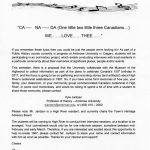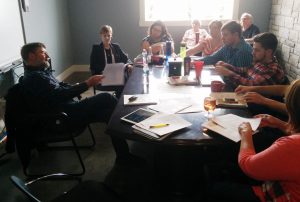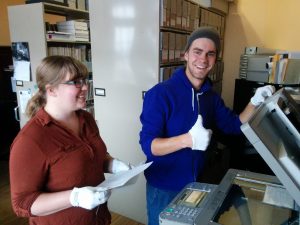“The Museum of the Highwood and the Placing Memory Project”
Irene Kerr, Director and Curator, The Museum of the Highwood
Panel: Placing Memory in High River: An Oral History Project
Conference: Alberta Museum Association Conference—A Culture of Sharing: Inquiring Minds, Empowering Museums, Calgary, September 16, 2016.
I think Kyle, Kaitlin, and Brittany have already done an excellent job summarizing the “Placing Memory” project. I am pleased to give you my perspective from the standpoint of a museum Director/Curator.
Kyle has already mentioned the High River Heritage Advisory Board. This was a board established by the Town of High River for the main purpose of establishing the Residential Heritage Inventory Project through the Municipal Heritage Partnership Program through Alberta Historical Resources Foundation.
This is where I first met him and I have to say I was very impressed with his enthusiasm for our local history. Sometimes, we museum types become so internally focused and overwhelmed by the work of keeping our museums going, that we neglect to reach out to our communities to recruit like-minded people who care about our history – they are out there!
The museum has a permanent position on the board and was an integral part of the program – providing the resources, research materials and most of the images for the Inventory Project. As we had already held 8 Historic Homes Tours, most of the houses that had been on the tours were candidates for designation and had already been researched. This program had three phases and ran from 2012 to 2015. Working with the Town of High River, volunteers, and Community Design Strategies was an interesting and at times challenging experience for the museum. Our human resources were extremely limited, we had just returned to our building following the fire, and then, of course, had to deal with the flood. However, it reinforced our belief in the extraordinary value of our research, archival and photographic collections and at times gave us that extra boost that we needed to carry on.

When Kyle decided to take the process a step further, I was thrilled. One of the greatest losses on the 2013 flood was the majority of our recorded oral history collection. As part of an exhibit we were creating, some of the recordings had been digitized by summer students, and several transcribed interviews were located in the main-floor archives, but all of the cassette tapes were destroyed. My first reaction was that this was an incredible opportunity for us to rebuild our oral history collection.
As Kyle mentioned, the work that had already been done on the Heritage Inventory Project provided a catalyst for the context of the interviews. The committee met and decided that the theme should be focused on a “Sense of Place” – using places to trigger memories. When you almost lose your community, it gives you a different perspective on what remains and the importance of remembering what was.

Not only were we able to work with students, but several community members stepped up to volunteer and were trained in the oral history process. Fortunately, Kyle and his very capable assistant Kaitlin took care of all the meetings and all the administrative details. I do regret that I was not able to be more involved in the process, but my workload was just too great.
I went to visit the class at Ambrose University and gave a presentation on the museum, a bit about the history of High River, and what it’s like to work at a museum. I presented a couple of examples of the process of researching and planning an exhibit. It was nice to meet the students in their own environment and to see how interested and enthusiastic they were.

I was more than happy to have the students come to the museum and to provide them with basic archival and research training. It was wonderful to see how excited they got when they found images that they liked, were relevant and could make a connection to. Our volunteer archivist and long-time High River resident Bill Holmes was also available to help them out.
Another positive aspect of this project for the museum is that we were able to meet several of our Strategic Goals that are part of our Strategic Plan:
#1 – create innovative programming and exhibits that are timely, unique and engaging, showcase the museum’s collection and support the needs of the community.
Once I began reading the interviews, I noticed a common thread. High River really was the happening place! Memories of places where people went to do business, have social interactions, recreation, education were all common threads. The generated a plan to create an exhibit called “Going to Town” and talk about the social, cultural and economic elements of High River past and present or locals and Highwood area residents.
#3 – increase awareness of the Museum of the Highwood.
The publicity generated by this project has raised the profile of the museum in the community and engaged people who may not have been reached. The online component and resulting exhibit will further help us to meet this goal.
#4 – engage the community and develop partnerships while enhancing the quality of cultural life in the Highwood area.
This is quite evident, not only have we developed new partnerships but we are also preserving our history through the voices of our citizens. The exhibit and associated programming will be enjoyed by people of all ages.
One of the highlights of this project for me was the “History Harvest” event that Kyle and his students facilitated at the museum on Saturday, November 21. 2015. People were invited to bring in artifacts that were important to them and tell the stories behind them. The plan was to photograph the artifacts and to record the stories. We surrendered the museum to the students who came in and set up their interview stations, arranged and conducted the interviews. There was an excellent turn-out and it was great to see the students greet the participants at the door, guide them to their tables and conduct the interviews. It was inspiring to see the interaction between these young students and their subjects.
An unexpected benefit that I realized that day was the variety of artifacts and photographs that were brought in. With my museum director’s hat on – I recognized potential accessions!
In closing, I would like to thank Kyle and the students for allowing us to be a part of this project. It was a pleasure to work with them, and I look forward to many more collaborations. I would highly recommend projects like this to other museums. We are all stretched for resources, and it is wonderful to have this help and to share our collections and knowledge. After all, these students are the future of our museums.
